

 Vol. 40 (Number 5) Year 2019. Page 12
Vol. 40 (Number 5) Year 2019. Page 12
PÁEZ, Félix A. 1; LUZARDO, Marianela 2; VERA, Pedro E. 3
Received: 17/09/2018 • Approved: 24/01/2019 • Published 11/02/2019
ABSTRACT: A diagnosis is made of the use that adolescents in public schools in the municipality of Piedecuesta, Santander, Colombia make of social networks, in order to determine the different risks by contact, content or commercial type that may be incurred when interacting individual or group way in the activities of these networks. There was a statistically significant relationship between age, people who see the profile, type of contact, among others |
RESUMEN: Se realiza un diagnóstico del uso que los adolescentes de los colegios públicos del municipio de Piedecuesta, Santander, Colombia hacen de las redes sociales, para poder determinar los diferentes riesgos por contacto, por contenidos o de tipo comercial en los que pudieran incurrir al interactuar de manera individual o grupal en las actividades de estas redes. Se obtuvo relación estadísticamente significativa entre la edad, personas que ven el perfil, tipo de contacto, entre otras. |
Today's world depends on a high percentage of technology and young people are the first to be up-to-date with innovations even though they may not only offer advantages but also risks. As for the use of the internet and in the specific case of social networks can become double-edged weapons. The adolescent, because of his natural curiosity, always wants to go beyond the limits, which can lead him to take risks such as entering unreliable or false sites (Mató, 2015), until he suffers from externalizing mental health problems (aggressive behavior, breaking of rules and attention problems) (Morrison and Gore, 2010), (Rodríguez and Fernández, 2014), (Ko, Yen, Liu, Huang and Yen, 2009), even though there are investigations that refute this fact as the case of Rodriguez and Fernandez (2014) that in their research on this type of problems explain that contrary to what the literature suggests, in a research carried out there is no difference between groups of use of social networks with respect to variables such as perceived loneliness, school social dissatisfaction, dysphoria and self-esteem.
The risks that may exist in this field have been studied and classified, according to De Moor et al. (2008), they define three categories: The first the risks of the content, in this case the users of a social network and especially the adolescents could find messages quite direct, as in an update of aggressive state or a publication on the wall of someone, but can also be indirect or more veiled as the case of joining hate groups, so it is important the critical sense at the moment to enter these sites.
The second category includes contact risks, which are those that are rooted in the fact that SNS (Social Network Sites) can be used to communicate and have contact with others (Lange, 2007) these SNS together with instant messaging are the most popular means used for cyberbullying (Livingstone, Haddon, Görzig and Olafsson, 2011), reaching the point of sexual abuse, since adolescents are prone to be manipulated, and face privacy risks, since they publish a lot of personal information online (Almansa, Fonseca and Castillo, 2013, Livingstone et al., 2011). Explains Livingstone et al. (2011) that 29% of teens maintain a public profile or do not know about their privacy settings and 28% opt for partially private settings so that friends-friends can see their page.
A study carried out by Gutiérrez, Vega y Rendón (2012) indicated that adolescents of both sexes provide their names (64.7% of men and 78% of women) and real ages on social networks. 79.6% of the respondents report that they like to chat in the Chat or Messenger. An important percentage (64.1%) has done it with unknown people. This qualitative research indicates that such acts occur when adolescents seek popularity.
The third category of risks refers to commercial risk, which includes the commercial misuse of personal data. The information provided to a company for a transaction can be shared with third parties through applications and user behavior can be tracked in order to provide targeted advertisements and social advertising (Debatin, Lovejoy, Horn and Hughes, 2009). In many cases the credit card data is registered and can be used by other people without authorization from the cardholder.
Even when these risks exist, some authors affirm that adolescents are beginning to be more critical and careful in the management of networks as evidenced in the work of Soler-Fonseca (2016) "the confidence of adolescents enrolled in social networks virtual ", in which he concludes that adolescents in school rely fairly on the relationships generated in virtual social networks; that is, they have provoked a critical thinking of them, which promotes prevention and self-care in the network. Likewise, it is highlighted that the most used virtual social network is Facebook and the most accepted virtual mobile application is WhatsApp, which are managed in and for school socialization.
Despite the fact that on the Internet and social networks very controversial approaches have been formulated, ranging from the association of its use with some mental health problems, to the consideration of the network as a skills enhancer and facilitator of the promotion of social relations and relatives Rodríguez, and Fernández. (2014). Likewise, the great utility offered by networks in bringing people together, especially young people, as well as their use in training, the dedication to digital technologies is transforming learning, socialization and communication between young people who can access and use them, generating new forms of associated expression, which entail new relational dynamics Rodríguez, and Fernández. (2014).
Returning to the issue of network problems, another concern raised by some authors is the use of time by young people, who dedicate a large part of the networks, a study by Sánchez and Martin (2011) in Argentina, Colombia , Ecuador, Spain, Mexico and Venezuela, found that between 80% and 90% of adolescents of school age make use of social networks, with Colombian adolescents showing the highest percentage of use. According to the Ministery of Information and Communications Tecnologies (2015), in Colombia 52% of the population uses the Internet daily for an average of three hours, with a percentage of use by adolescents of 98%.
But this fact is not entirely negative, there are studies that find positive effects, attributable to the fact that adolescents can stay longer at home, which entails an increase in communication with their parents, generating new forms of interaction (Barrera, 2012) .
Apart from messaging and chatting on social networks, there are practices that are becoming increasingly popular among young people, one of them being photo sharing (this is a practice based on the production and publication of images to stimulate Sociability in online social networks, has been driven by a series of technological and socio-cultural changes that have occurred in parallel to the development of Internet 2.0 Basile and Linne (2015). By observing the performance of young people on Facebook, we can see the phenomenon that is occurring in terms of the predominance of images, the posting and comment of personal photos occupies the central place (Mendelson et al, 2010) and sociability through writing occupies a secondary place (Linne and Basile, 2012).
Adolescents want to appear within their world and be popular and do not measure the scope of the images they send. Young women and children make their public profile on social networks to be valid in the collective of all their acquaintances and strangers. In many cases these images have a sexual rather than artistic tone and can be used by malicious people for other purposes. As a result of the socialization of these images, victims may suffer collateral effects such as guilt, depression, low self-esteem, difficulties concentrating, aggressive behavior and repressed anger and distrust. Cabello and Fernández cited by Gutiérrez, Vega y Rendón (2012). Part of these risks through contact with strangers are exposed in the work of Gutiérrez, Vega y Rendón (2012) that reveals that Mexican girls and boys make public truthful information of their person (around 70%) and interact with strangers on the Internet (around 64%). These percentages seem higher than the European average with a public profile of unrestricted access in social networks (57%) as well as the European average that interacts with strangers (34%).
According to the previous review, it is evident that there is not enough research in Colombia (Torres 2010) regarding the use of social networks, nor its relationship with the different risks that these represent for current youth, for this reason, this work was proposed to a diagnosis of the use of different social networks by adolescents in the municipality of Piedecuesta Santander. Once these variables have been studied, it is intended to propose a pedagogical strategy aimed at mitigating these risks associated with the networks used by the adolescents of this municipality and thus create pedagogical indicators aimed at obtaining the benefit of the use of these means.
These pedagogical strategies can turn into something useful the charm that adolescents feel by the use of social media, Junco (2011) found that the use of Facebook in education has a positive impact on the academic performance of students, idea that supports Amador and Amador (2014), who found that students consider Facebook to be a beneficial platform for their academic career. For López, Flores and Espinoza de los Monteros (2015), "Facebook has educational and administrative applications that help facilitate different tasks, beyond immediacy and ease of access"
For their part, Balula and Moreira, (2014) explain that children and young people use networks for their daily activities, consult their states and messages several times a day, connect from cell phones and tablets they carry with them everywhere and at school they are more interested in these virtual spaces than in the reality they have in front of the blackboard; students get bored easily and need a variety of stimuli; They are impatient and expect an instant and attractive gratification, this interest should represent an advantage for the teacher and thus make the student be motivated to be a better researcher and feel the autonomy of their work.
This initiative can find great support in Colombia since despite the fact that the work with ICT has been a bit weak and in some cases without clear goals or objectives, the Colombian government, through the Ministry of Information and Communication Technology , has proposed a strategy called "In ICT I trust", which promotes the safe and responsible use of Internet and new technologies (MinTIC, 2015).
Every day the world of networks becomes more accessible, which is why Marck Zuckerberg, creator of Facebook, as he reported in 2015, has introduced into the world of cyberspace Internet.org, a means with which he is trying to resolve is that (Internet) is affordable and people are aware of it. Trying to give a small package of pre-basic services will improve people's lives. According to Zuckerberg, it means that people, having their first experience on the Internet, begin to understand the value of the network, and then start paying to have access to it and improve their lives. Even Internet.org launched a Colombian version of Facebook, with typical expressions of the country, this as part of making the Internet affordable is to make sure that the content to which people have access is relevant and that includes the way in which it is presented. Thus, when Internet.org is launched in each country, it is done in such a way that the language is also a very important part, this fact shows even more the proximity of the networks to the different users.
Social networks and in general new technologies are here and will continue to occupy more and more spaces, the most sensible to take advantage of them and include them within the educational fact in order to combat the risks they may represent and turn them into allies of learning.
This is a non-experimental, descriptive, correlational cross-sectional investigation that used the survey as an instrument to collect the information.
The universe under study of this research is made up of all the students of grades 8 to 11 of the public schools of the municipality of Piedecuesta, Santander, Colombia.
Initially there were 5389 students however, after the retirement of two schools due to the unwillingness of their directors to collaborate, the target population was formed by 4199 students.
Two-stage sampling was carried out by selecting proportionally, within the schools, the students of the different grades. In this sense, in Fig. 1 it can be seen that the proportion of people in 8th grade is higher than in the consecutive years, in the sample, in the population, however, for the other grades is not much difference.
Figure 1
Sample

Source: research results
The sample consisted of 614 students, which corresponds to 14.62% of the target population and 11.4% of the universe under study.
A survey of 38 questions adapted from the instrument applied by Sánchez and Martin (2011) and validated by a group of expert researchers from different universities in the region was applied.
The first part of the instrument refers to sociodemographic data, and then inquires about the use of electronic devices and access to the internet. Section three describes the habits of Internet connection, knowledge about social networks and information registered in them, among others. The fourth part explores the perception that adolescents have about commercial, contact and content risks.
To organize the information of the student surveys, the database was constructed and the information was processed through the statistical package IBM-SPSS version 25.
First, a descriptive study of the sample was carried out in terms of demographic data, possession of communication devices, social networks. Then, from the non-parametric chi-square statistic, tests were carried out that allowed to know the relationship between the demographic variables and those associated with the different types of risks.
The sample under study is characterized by being female (51%), strata 2 and 3 (84.2%) with an average age of 15 years and standard deviation of ± 1.3.
With regard to the possession of electronic devices, it can be seen that mobile is the most common among adolescents, as shown in Fig. 2, and only 18.2% have a data plan for their use. In this sense, it is observed in Fig. 3 that the majority connects from the school. On the other hand, it should be noted that 40.6% know internet.org
Figure 2
Possession of mobile devices
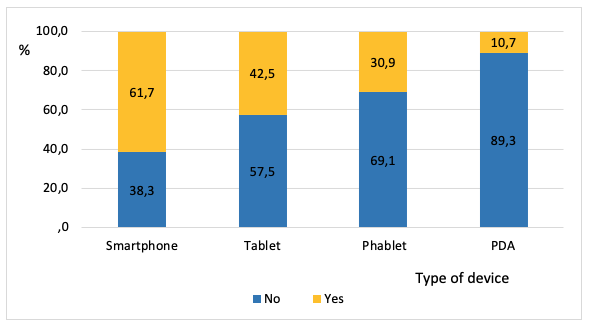
Source: research results
-----
Figure 3
Connection place
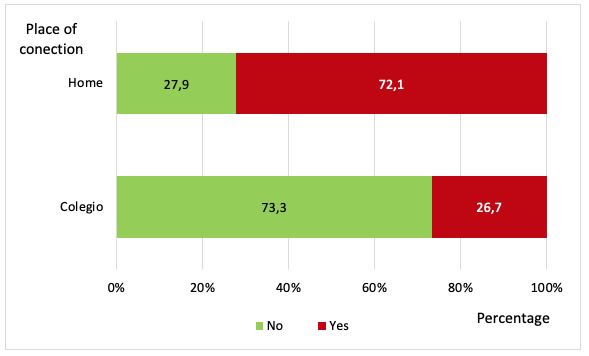
Source: research results
It was obtained that of 85% of the users that connect to the internet from the home, 38.9% do so from their bedroom and 53.8% from the living room.
The study highlights the great influence of friendships in the knowledge of virtual communities with 52.6%, followed by that of their families with 25.4%, the remaining 22% is distributed among: by chance (10.6% ), by advertising (9.3%), does not know 2% and does not respond 0.2%.
The use of Facebook is the most common among students of public schools in Piedecuesta, followed very close to Instagram as shown in Fig. 4. However, only 36.2% of students state that they always verify the veracity of the information that is published in the social network using other means or sources of consultation.
Figure 4
Preferred social networks
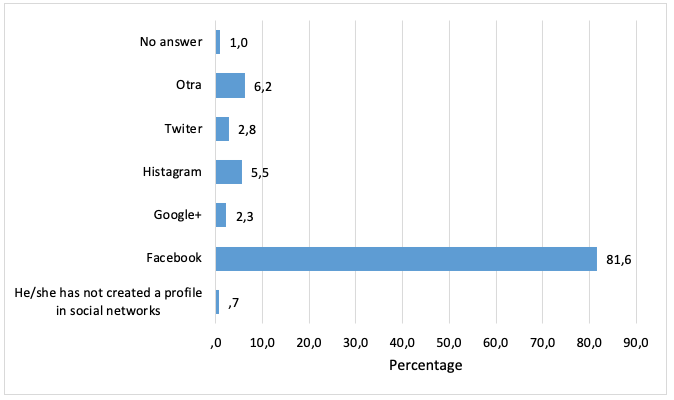
Source: research results
The majority of the students were characterized by connecting to the internet between half an hour and two hours as shown in Fig. 5.
Figure 5
Internet connection time
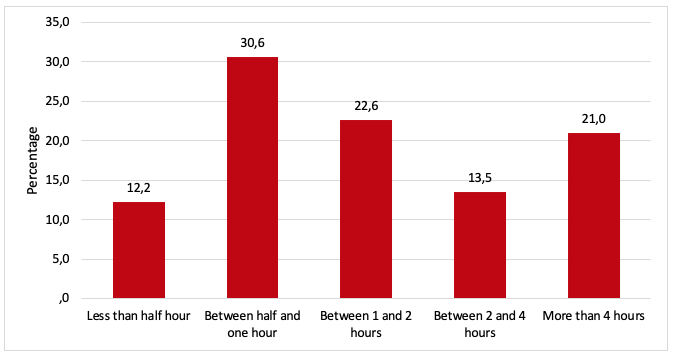
Source: research results
As shown in Fig. 6, of the adolescents who perform some action with respect to the publications in the social networks to which they have access, they stated in 80.2% that they always verify that what is published is true, however, almost 20% do not believe in that published information.
Figure 6
Life without social
networks is boring

Source: research results
-----
Figure 7
Action taken with respect to the
publication on social networks

Source: research results
It should be noted that when crossing between the fact that the student feels that life without social networks is boring and the sociodemographic variables, statistical significance was obtained with the degree being studied (p-value = 0.015) and the socioeconomic stratum ( p-value = 0.003).
Regarding the actions they have carried out in a social network, 75% of the adolescents from the state of Puebla said they did not take any action, however, of the remaining 25%, 30.9% took negative actions towards another person, 23.7% has made rude, abusive or malicious comments on the profile of a third party and 23% publishes photos / videos without authorization (Fig. 8).
Figure 8
Actions in the network
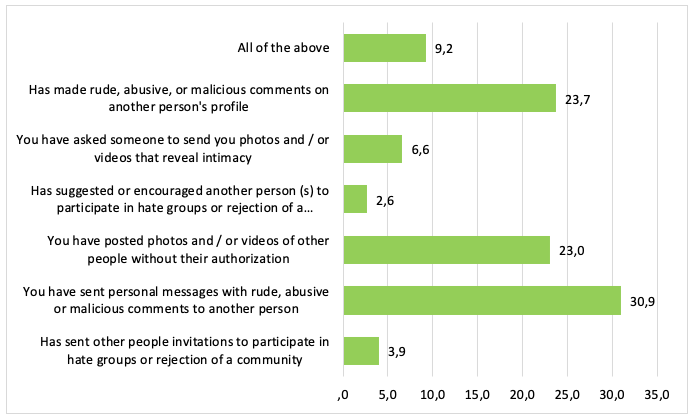
Source: research results
On seeing the dependence between these variables and the sociodemographic ones, a statistically significant relationship was obtained with gender (p-value = 0.037) and with the social stratum (p-value = 0.008)
In this section are presented those variables that can lead to contact risk of adolescents as they are: who can see their profile, the times they have established friendship or another relationship with strangers on the Internet, the times they have personally met with some unknown person who has known or established contact on the Internet, the degree of preference to share with friends in a personal and / or virtual way, types of contact he has on social networks.
It was obtained in the study that the students of the public schools of Piedecuesta 56.7% have their profile open only for friends, 25.6% state that anyone can see it, 6% friends of friends and 11 , 7% do not know.
It should be noted, as shown in Fig. 9, that more than 50% of students have become friends or other relationships with strangers and that 31.1% have personally met with this type of person.
Figure 9
Frequency of friendship
and contact with strangers

Source: research results
Another interesting fact that the collection of information throws is that students in 48.2% say that they prefer to spend more time with friends in a personal way than through social networks however; more than half prefer to do it at least sporadically through digital channels.
The most frequent contacts among the students are their relatives (parents or not) and their friends (33.7%), but a high percentage only has friends in social networks as shown in Fig. 10
Figure 10
Contacts in social networks

Source: research results
When cross-referencing these variables with the demographics, a statistically significant relationship was obtained from the chi-square test between:
- The school where he studies with the type of contact they have in social networks (p-value = 0.025);
- The school where you study with people who can review the profile (p-value = 0.05);
- Degree that the student studies with the people who can see the profile (p-value = 0.001).
- Degree that attends the times you have established friendship or another type of relationship with strangers (p-value = 0.05)
- Degree that goes with spending more time with friends online than in person (p-value = 0.001)
- Degree that deals with the type of contact they have in social networks (p-value = 0.033)
- Age with people who can see the profile (p-value = 0.05)
- Age with the number of times you have established friendship or another type of relationship with strangers (p-value = 0.05)
- Age with spending more time with friends over the internet than personally (p-value = 0.001)
- Age with the type of contact they have in social networks (p-value = 0.008)
Regarding the commercial risks, it was obtained that the students put in their profile demographic information with photos in 63.1%, and without the photos the remaining 36.9%
This variable had a statistically significant relationship with the student's age and grade (p-value = 0.05)
As observed in the results of the research in the participating population, the majority of users of social networks are female with an average age of 15 years, who make up a population with a high degree of vulnerability to the different risks of the networks. The most used device is the mobile phone or Smartphone, followed by the tablets, the phablets and finally the PDAs. Thus, the risks are accentuated since devices with as easy portability as telephones can accompany adolescents almost anywhere and in some cases they can use them without supervision of parents or teachers, which constitutes a content risk.
Regarding the place of connection, the majority do so from home, which can have its advantages when the teenager stays longer in his home with their family, although this does not exclude the isolation of being more concentrated in the networks or in the cyberspace than in personal relationships with their relatives. The surveys also revealed that the people with whom they communicate most through the networks are their friends, followed by relatives and casual relationships that in many cases are with strangers which constitute a serious danger of contact. The most used social network is Facebook, and then this Instagram accompanied in both cases the danger that only 36.2% verify with whom he/she communicates. In relation to the time spent by these connected teenagers, it could be verified that it is only from half an hour to two hours, which could be taken as a moderate period of time.
When asked about actions in the networks, the results showed that 75% do nothing only reviews, and 25% sends messages to other people or groups, others publish photos or videos without authorization, request photos to other people even unknown and in some cases come to incite and invite to participate in hate groups.
In the aspect related to the profile of these young people a high percentage has its profile open only to friends, while more than 30% have it accessible to all even strangers which can constitute a high risk of contact with the possibility of reaching to get involved in highly dangerous relationships.
Finally, many of these users present demographic data even with a photo that may be available to anyone who could abuse them fraudulently, this fact becoming a commercial risk since unscrupulous people can observe the economic level of these young people and try to obtain from them or their relatives money in different ways.
A large number of teenagers, users of Facebook, Instagram, WhatsApp, and other networks distrust the people with whom they interact, but do not suspect the Network itself, which can be a risk with malware (viruses that capture information) , which can compromise personal information, location, confidentiality of conversations and even the identity of their contacts.
More training is required regarding the correct use of ICTs, which motivates significant and real changes in teaching and family practices, so that they understand and contribute to the integral education of young people and so that they can assume the positive aspects of these tools, for the sake of improvement both pedagogical and social. Soler-Fonseca (2016). The educational centers and the family have not taken clear positions on the use of networks and their interference in daily life or in education; which can be taken as confident attitudes, by accepting in a broad and open way the participation of young people in these, with a total disinformation before the risks that run the users of the networks.
Albarello, F. (2011). Leer y navegar en Internet. Buenos Aires: La crujía.
Almansa, A., Fonseca, O., & Castillo, A. (2013). Social Networks and Young People. Comparative Study of Facebook between Colombia and Spain. Comunicar, 20(40), p.127-134.
Amador, P. y Amador, J. (2014). Academic advising via Facebook: Examining student help seeking. Internet and Higher Education, vol. 21, pp. 9-16. https://doi.org/10.1016/j.iheduc.2013.10.003. 10.1016/j.iheduc.2013.10.003.
Balula, A. y Moreira, A.. (2014). Evaluation of online higher education learning, interaction and technology. Suiza: Springer.
Barrera, V. D. (2012, abril). Usos y significaciones del Internet en familias con hijos adolescentes. III Seminario Nacionalde Infancia y Adolescencia, Ciudad de Medellín, Colombia.
Basile, D. and Linne, J. (2015) Adolescentes y redes sociales online.
El photo sharing como motor de la sociabilidad. Cuadernos del centro de estudios en diseño y comunicación . Buenos Aires. Versión on line.
Debatin, B., Lovejoy, J.P., Horn, A-K. & Hughes, B.N. (2009). Facebook and Online Privacy: Attitudes, Behaviors, and Unintended Consequences. Journal of Computer-Mediated Communication, 15(1), p. 83-108.
De-Moor, S., Dock, M., Galles, S., Lenaerts, S., Scholler, C. & Vleugels, C. (2008). Teens and ICT: Risks and Opportunities. Belgium: TIRO. (http://goo.gl/vvNl2z). Recuperado en: http://www.belspo.be/belspo/fedra/TA/synTA08_en.pdf. (21/02/2017).
Gutiérrez, R., Vega, L.,Rendon, A. (2012) Usos de la Internet y teléfono celular asociados a situaciones de riesgo de explotación sexual de adolescentes. Salud Ment vol.36 no.1 México ene./feb. 2013
Journal of Technology and Educational Innovation, vol. 1, núm. 2, pp. 106-114.
Junco, R. (2011). The need for student social media policies. Educause Review, vol. 46, núm. 1, pp. 60-61. Recuperado de http://er.educause.edu/articles/2011/2/the-need-for-student-social-media-policies.
Ko CH, Yen JY, Liu SC, Huang CF, Yen CF (2009) The associations between aggressive behaviors and internet addiction and online activities in adolescents. J Adolesc Health. 2009 Jun;44(6):598-605.
Lange, P.G. (2007). Publicly Private and Privately Public: Social Networking on YouTube. Journal of Computer-Mediated Communication, 13(1), p. 361-380.
Linne, J. y Basile, D. (2012). Hábitos de uso de Internet en adolescentes de sectores populares, ponencia presentada en el Congreso Internacional ISA, 1° al 4 de julio del 2012, Buenos Aires.
Livingstone, S., Haddon, L., Görzig, A. & Olafsson, K. (2011). Risks and Safety on the Internet: The Perspective of European Children. Full Findings. London: LSE: EU Kids Online. Recuperado en: http://www.lse.ac.uk/media%40lse/research/EUKidsOnline/EU%20Kids%20II%20(2009-11)/EUKidsOnlineIIReports/D4FullFindings.pdf. (26/02/2017).
López de la Madrid, M., Flores G. K., Espinoza de los Monteros, A. (2015). Diversidad de usos de Facebook en la educación superior. Análisis desde un estudio de caso. Innoeduca, International
Mató, E. (2015).Adolescentes: mal uso de Internet.MAPFRE TECH: canal salud. Recuperado en http://www.mapfre.es/salud/es/cinformativo/adolescentes-Internet.shtml. (26/02/2017).
Mendelson, A. et al (2010). Look at us: Collective Narcissism in College Student Facebook PhotoGalleries, in The Networked Self: Identity, Community and Culture on Social Network Sites, Papacharissi, Z. (Ed.). Illinois: Routledge.
MINISTERIO DE TECNOLOGÍA DE LA INFORMACIÓN Y LA COMUNICACIÓN. (2015). En TIC confío, la estrategia de MinTIC para usar Internet de forma segura. Recuperado de: http://www.mintic.gov.co/portal/604/w3-article-11446.html.
Morrison, CM. And Gore, H. (2010) The relationship between excessive Internet use anddepression: a questionnaire-based study of 1,319 young people and adults Psychopathology. 2010;43(2):121-6. doi: 10.1159/000277001
Rodríguez, A. Paola, y Fernández, A.. (2014). Relación entre el ttiempo de uso de las redes sociales en Internet y la salud mental en adolescentes colombianos. Acta Colombiana de Psicología, 17(1), 131-140. Retrieved August 21, 2018, from http://www.scielo.org.co/scielo.php?script=sci_arttextypid=S0123- 91552014000100013ylng=enytlng=es.
Sánchez, A., y Martin, A. (2011). Informe Generación 2.0 2011.Hábitos de uso de las redes sociales en los adolescentes de España y América Latina. Recuperado el 24 abril del 2012, de: http://www.slideshare.net/ucjc/generacin-20-2011-hbitos-de-usos-de-las-redes-sociales-en-los-adolescentes-deespaa-y-amrica-latina
Soler-Fonseca, A. (2016) Confianza de los adolescentes escolarizados en las redes sociales virtuales. Praxis & Saber, 7(15), 231-246. https://dx.doi.org/10.19053/22160159.v7.n15.2016.5734
Torres, Y. (2010). Situación de salud mental del adolescente. Estudio Nacional de Salud Mental Colombia. Bogotá: Ministerio de la Protección Social. Recuperado el 9 de marzo del 2012, de http://www.onsm.gov.co/ www.elpais.com.co/colombia/que-es-internet-org-del-creador-de-facebook-mark-zuckerberg.html
1. Licenciado en Matemáticas, MSc. Matemáticas, Estudiante de Doctorado en Educación, Profesor Asociado, Universidad Pontificia Bolivariana, Bucaramanga, Colombia. Email: felix.paez@upb.edu.co
2. Licenciada en Estadística, MSc. Estadísticas, PhD. en Estadística. Profesora Asociado, Universidad Pontificia Bolivariana, Bucaramanga, Colombia. Email: marianela.luzardo@upb.edu.co
3. Licenciado en Matemáticas, MSc. Matemáticas, Estudiante de Doctorado en Educación, Profesor Asociado, Universidad Pontificia Bolivariana, Bucaramanga, Colombia. Email: pedroelias.vera@upb.edu.co